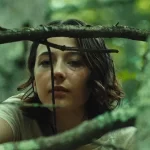Sundance 2021: Eight for Silver, by David Bax

Sean Ellis first made his name with an insufferably self-satisfied, cutesy/creepy short film called “Cashback” in 2004. Too put off by that effort, I hadn’t checked back in with his work until the new werewolf flick Eight for Silver. In many ways, Ellis has grown and in a few he hasn’t but, all things considered, I prefer him spending his time gorily ripping flesh and severing extremities than lasciviously undressing actresses treated like mannequins.
Eight for Silver starts by dropping us into a different kind of horror, a more realistic and manmade one in the mustard gas-clouded trenches and bullet-fogged air of the First World War. A hunk of silver removed from the body of a dead soldier leads us to our main story, an extended flashback to late nineteenth century France, where a group of Irish settlers violently remove a large family of Roma from their land and pay a deadly price in the form of a curse.
Ellis’ smartest move, as both director and screenwriter, is not to try to reinvent the wheel (though he does play fast and loose with certain limitations of werewolf mythology). Eight for Silver is a classical monster movie, skirting the boundaries of schlock but never placing its tongue in its cheek. Things start to get especially exciting–at least to the genre’s acolytes–when Ellis introduces John McBride (Boyd Holbrook), an archetypically capable werewolf hunter. A highlight, wordless sequence in the woods captures some that hunter vs. hunter, Predator-style macho magic.
Eight for Silver‘s most distinct stroke of novelty would appear to have been an accident, given that the film was written and largely shot before the discovery of COVID-19. The film takes place in the middle of a cholera pandemic. McBride is a pathologist who takes his time and resources away from that pressing problem to study lycanthropy as a virus–observing infected blood cells under a microscope–much to the consternation of local officials convinced one wild animal shouldn’t take precedent. An epidemic and the refusal of those in power to listen to the experts makes Eight for Silver a little more relatably horrific than may have been intended.
Certain elements of supernatural horror still seem to be outside of Ellis’ grasp, though, with far too much reliance on now-dated, early 21st-century tricks like quick flashes and speed ramps accompanied by screechy noises. Eight for Silver‘s most masterfully disturbing sequence comes before any werewolves show up. The massacre of the Roma camp is shown in one, discomfiting static shot from a chilly distance, as Ellis choreographs a sickening progression from one gunshot and one dead body to dozens of slain innocents and tents and carts afire. By the time we get to the film’s annoying blurry, shaky cam climax (possibly a way around costly CGI), it feels like a let down. There’s more to like than not in Eight for Silver. It’s just a shame it ends on a misplayed note.




























Late nineteenth century France sounds like an odd place for Irish settlers to be. I was under the impression the country had been settled long before that by the ancestors of French people. I also didn’t think that the Roma owned land. I recall Yuri Slezkine describing them as one of his “Mercurian” populations (in contrast with the “Appollonians” who made up the nobles & peasantry) who don’t own and work land but instead engage in specialized trade with a larger population.
Honestly, it’s not 100% clear in the movie but Irish settlers in France was my educated guess.
I intentionally didn’t use the word “own” but the Roma in the movie do present evidence of a claim on the land.
– David
Considering the villa (plantation?) is repeatedly referred to as a “settlement” in the film, I think it’s reasonable to refer to them as Irish settlers.